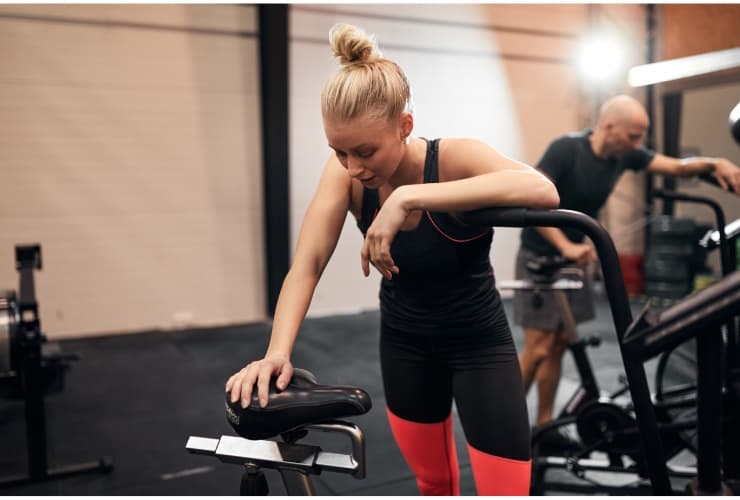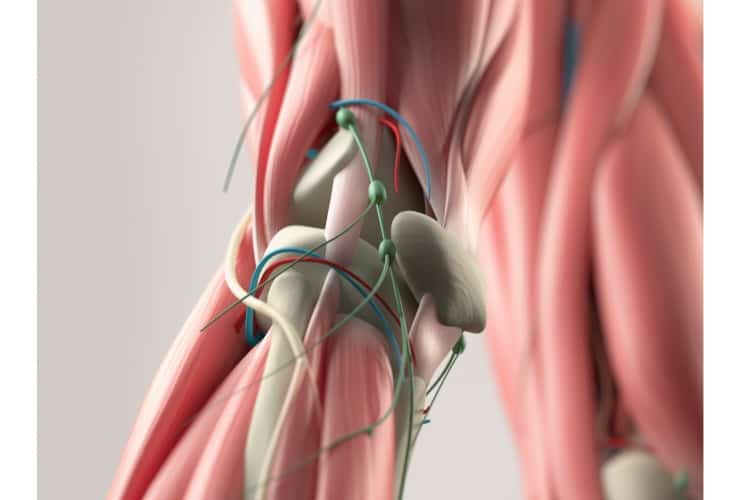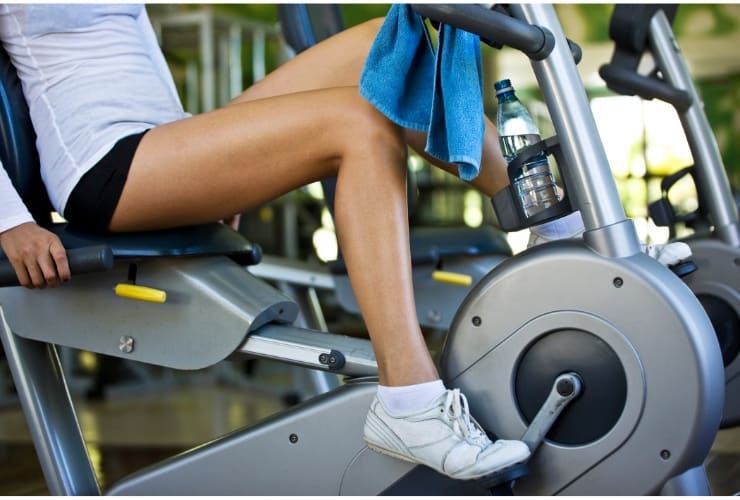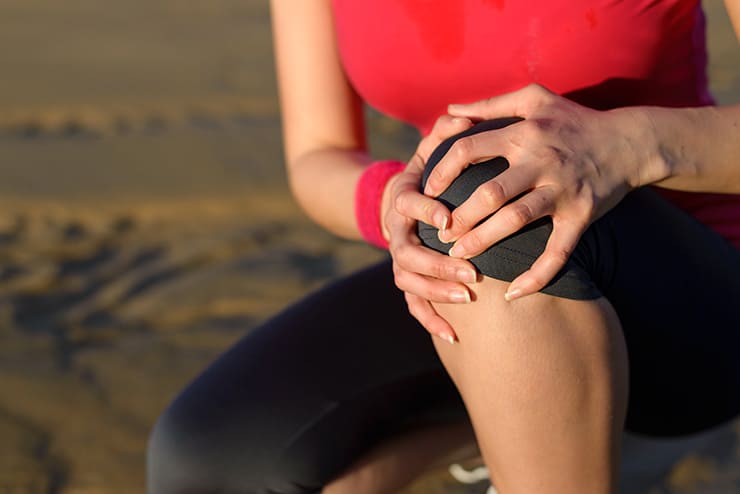If you’re here because your knees are bothering you after riding your Peloton, you’re not alone. In fact, 23-33% of cyclists experience knee pain at some point, according to one study that examined the non-traumatic injuries of amateur cyclists.
There are plenty of reasons you could be experiencing pain, from bad form to lousy stretching to an improper pedal stroke. Before running to the doctor, read on for simple solutions.
Key Takeaways
- Knee pain is a common problem for cyclists, and it can have different causes and locations depending on your bike setup, riding style, and stretching habits.
- Adjust your saddle height, position, and angle to reduce the strain on your anterior, posterior, medial, or lateral knee muscles and tendons.
- Also, check your cleat alignment and pedal resistance to ensure a smooth and balanced pedal stroke that does not put excess pressure on your knees.
- You can prevent and relieve knee pain by doing proper warm-up and cool-down stretches, as well as strength training, yoga, pilates, and foam rolling exercises that target your core, legs, and joints.
- Peloton offers a variety of classes and resources to help you find your optimal bike fit, improve your riding technique, and avoid injuries.
Can Riding a Peloton Give You Knee Pain?
Yes, riding a Peloton as well as any kind of stationary bike (or outdoor bike) can result in knee pain. If your knees hurt, it’s important to figure out why so you can mitigate and prevent pain next time you hop on your Peloton bike.
The next sections will outline the main reasons for and the type of pain you are experiencing so you can identify the source and make the necessary changes.
Why Are You Experiencing Knee Pain When Riding Your Peloton?
There are a number of reasons you may be experiencing knee pain when riding your peloton. As we’ve already discussed, peloton knee pain (or knee pain when cycling in general) is actually very common, so it may not necessarily mean that there is anything serious going on.
The pain you experience could be due to any one of the following:
Overuse Injuries

Yes, the main reason why many users experience knee pain is simply due to riding too much.
You may be riding too frequently, but more likely, you are going too hard when you do ride. Consider doing a level test or FTP (functional threshold power) ride on Peloton to see your current fitness level.
You can use this metric to analyze your maximal input-output to ensure you ride at the level appropriate for you.
Your legs do need muscle tone in order to work optimally on the bike, and once this muscle has developed, injury is less likely. If overuse is the cause of your knee pain, be sure to give yourself ample rest between rides and don’t push yourself beyond your limits.
Incorrect Riding Posture
Another leading cause for knee pain when cycling is incorrect riding posture. You should not be straining your back as you ride, nor should you be stretching your knees too much to reach the pedals. Your ¨perfect bike fit¨ or “bike setup” are terms to describe your optimal seat height and handlebar distance.
To adjust your seat, hop off and align the seat height to just where your hip bone lies. This tends to be the proper height for most people. However, as everyone’s legs are a different length, you may need to make additional adjustments to find your ideal saddle height.
It’s also crucial that your saddle is not too far forward nor too far back. This could mean when pedaling, your knee is extended too far over your foot. We will explore this more further in the article.
To ensure your handlebars are at the proper length, loosen the lever on the front of your Peloton. Your handlebars should be at a comfortable height; Peloton recommends setting the bars at the highest setting at first. If you feel strain, lower the handlebars.
If you are still struggling to find your perfect fit, the peloton instructor Matt Wilpers has connections to plenty of bike fit professionals who can help you out.
Pedal Dysfunction
Your pedals are what drive your exercise. Therefore, it’s crucial that they are functioning properly, your cleat position is adequate, and your bike is set to the proper resistance.
If your resistance is too light or you set it to too much resistance, your foot may be slipping out of the pedals, which results in excess pressure on your knees. This also could mean you need different shoes.
Lack of Stretching
It sounds simple, but allotting time to stretch before and after your workout works wonders for your muscles and joints. Another tip – don’t skip the cool-down ride, which helps your body flush the lactic acid buildup in your muscles.
What Type of Knee Pain Are You Experiencing?

Identifying the area of pain can give major insight into the cause of pain. Read on for tips on how to make changes to mitigate your pain. Before you read on, there’s some important vocabulary to familiarize yourself with regarding what is known as a pedal stroke. Note that your downstroke is when you pedal downward.
This pushes your leg and consequently the pedal from a 0 to 180 degree angle. Your upstroke is the “recovery stroke,” caused from the force of the downstroke. It’s when your pedals finish the circle, going from 180 to 360 degrees.
Anterior Knee Pain
If you feel pain at the front of your knee, towards your knee cap, this is anterior knee pain. Let’s take a look at the different kinds of anterior knee pain, what causes this type of pain, and what you can do to help mitigate this.
Quadricep:
The quadricep is a tendon on your lower thigh right before your knee begins. Quadricep pain is characterized by swelling or a pinched feeling where your knees begin. This kind of pain can be mitigated by raising your saddle.
If you ride with a saddle that’s too low, your knees will over extend when you pedal. We also recommend stretching after riding if you experience pain here.
Patella Pain
The patella is another word for your kneecap, and refers to the bone that sits on top of your knee. Pain in the patella can indicate that your knee cap and thigh bone are creating friction by chafing one another. As with quadricep pain, it could also mean that your bike seat is too low, causing you to overextend your leg.
Pain Below the Patella
Under your kneecap lies soft tissue, which is more subject to damage from riding. If you encounter pain here, it may be because you are simply overusing your bike or stressing your joints too hard. And, you guessed it, a low saddle can also result in this kind of pain due to compressing the patella during your upstrokes.
Tibia and Iliotibial Band
Your tibia is the bone in your leg connecting your knee to your ankle. The iliotibial band is a piece of connective tissue that links together your hip and knee. These body parts are working hard when you cycle, and you put added pressure on them when your bike seat is too high, which makes you hyperextend your leg to be able to pedal.
Posterior Knee Pain
Your posterior knee is the back part of your knee cap. If you are experiencing pain in this area, it’s likely that your saddle is too high which leads you to overstrain your knee during the lower part of your pedal strokes.
Hamstring
Your hamstring is the muscle behind the front of your thigh. As you ride, your hamstrings facilitate the bending of your knee. Tightness in the hamstrings is common, and is preventable with a good stretching.
The leading cause of pain in the hamstring is due to overuse of these muscles as they work to draw up your legs in the upstroke. Consider using a foam roller after your workout, either before or after you stretch, to help with this pain.
Upper Calf
The upper calf is the chunk of muscle under your knee. Yes, you guessed it – pain in the upper calf is likely due to a saddle that’s too high and the intense pressure placed on these muscles.
Pain on the Inside or Outside of the Knee
Pain on the inner side of the knee (closest to your other knee) is known as medial knee pain, whereas pain on the outside of your knee is known as lateral knee pain.
Medial knee pain is likely the result of poorly positioned cleats. This could mean that your knees need to be closer to your bike to prevent strain on your inner knee.
Lateral knee pain can also be caused from poor cleat positioning. Biking with your knees very close to your bike will put too much pressure on the outer knee.
How Can You Prevent Knee Pain When Riding a Peloton?

Lucky for Peloton riders, there are preventative solutions for your pain. We’ve touched on the different adjustments you can make when different parts of your knees hurt.
Now that you have the information to identify where your pain is, take a look at how to properly adjust the different parts of your bike, according to that pain.
Saddle Adjustments
Whether you will need to heighten or lower your saddle on your Peloton bike depends on where your knee pain is. Anterior knee pain likely warrants a raised saddle height. This will lower the pressure placed on your front patella and joints. If your seat is higher, your knee will bend less, resulting in less strain.
You can also push your seat back if you are experiencing anterior pain. This will allow a wider margin for your knees to rotate and a larger pedal stroke.
On the contrary, if you are experiencing posterior knee pain, you should try lowering your seat height. This prevents your knee joints, calves and hamstrings from straining too hard on the upstroke. Experts also recommend pushing your saddle forward to lessen the pressure on these muscles.
Cleat and Pedal Adjustments
It is vital that your cleats are fully straight and properly calibrated to your pedals. Even if you have the slightest incorrect angle, your entire ride could be faulty and lead to injuries.
If you are experiencing inner knee pain (medial pain), you should adjust your cleats so that they are closer to your bike.
If you are experiencing lateral or outer knee pain, widening your cleats and pedals to
increase the distance between your two feet will ease the strain on those outer muscles.
Are there Classes You Can Take to Help Your Knee Pain?
If you’re really struggling with knee pain and want to be proactive in helping to reduce your discomfort, you’re in luck. There are plenty of classes you can take to ameliorate knee pain without even leaving your Peloton bike.
A Peloton subscription comes with access to numerous classes with Peloton professionals including stretching, strength training, yoga and pilates. All of these classes can help strengthen core parts of the body which can offset pain.
The classes are not only limited to helping knee pain – but will also ease back pain, hip pain, and more. If you are seeking additional resources regarding knee pain on your peloton bike, check out this video.
The Bottom Line
The famous saying goes, “no pain, no gain.” However, knee pain is unpleasant for anyone and can result in serious injury if not properly attended to. Luckily, there are many simple adjustments you can do on your Peloton to prevent such pain in the future.
The aforementioned tips will improve your riding game when implemented. Remember, your pain could be simply rectified from setting time to stretch and foam rolling after your workout.
Peloton also avidly tries to prevent any kind of bike-related pain for its patrons by offering effective stretching and strength building classes, so leverage that membership to your advantage.
Did you learn anything new from this article? Let us know what adjustments worked or didn’t work for you in the comments!.

